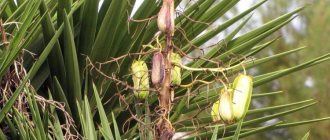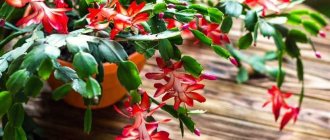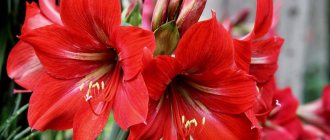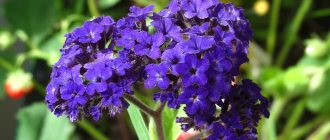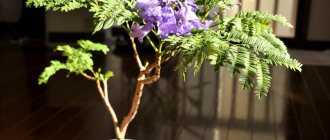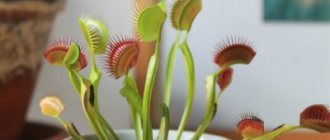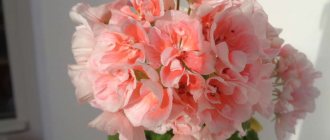Types and varieties
Of all the varieties of yucca, only giant yucca is traditionally considered a houseplant. Other species are cultivated much less frequently indoors:
- Yucca aloefolia;
- Yucca filamentosa;
- Yucca glaucous.
All of them are slow growing crops. Other types and varieties of yucca are grown in open space.
Giant (Elephant)
Yucca elephantipes is the more common name for giant yucca (Yucca gigantea). This is due to the fact that the older the plant, the more its trunk resembles an elephant's leg.
This is the most undemanding species in terms of care.
The young specimen develops as a bush. In an adult plant, the tree-like stem is highly branched at the apex. Because of this, it is often confused with a palm tree.
The trunk is not always single. When trimmed correctly, multiple peaks are formed. In flower shops, such specimens are called branched yucca.
Domestic specimens of giant yucca have leaves 6-8 cm wide and up to 115 cm long. They are hard and rough to the touch. Collected into rosettes and painted dark green. The edges of the plates are covered with jagged edges and end in a sharp spike.
The species elephantipes includes several varieties of yucca. Each of them has its own distinctive features:
- Silver Star - on each leaf plate there are 3 stripes (in the center - wide light, in the upper part - gray-green, on the reverse side - white-green);
- Jewel - in the middle of the leaf there is a wide gray-light green stripe, in the center of which a cream line is sometimes drawn; along the edges the leaves are dark green;
- Puck - leaves are light green, without a pattern, the most common variety.
In nature, elephant yucca blooms in multi-flowered panicles made up of many bell-shaped buds.
Aloe leaf
Yucca aloifolia, compared to giant yucca, is a more demanding species in terms of maintenance conditions.
The leaves are leathery, dark green with a bluish tint, and have serrated edges, like those of elephant yucca. The plates are wide, reaching 15 cm at the base, tapering towards the end. The leaves grow up to 55 cm in length.
Yucca aloe leaf has a pronounced trunk, which branches much less than that of giant yucca. Due to this, the crown of an adult plant is almost spherical.
Another important difference between the 2 types is the thickness of the trunk. In Yucca aloe leaf it is thinner and its core is softer. Therefore, timely pruning is important for her. A plant that is too tall may break under the weight of the crown and fall.
The most popular varieties of aloe yucca are Marginata and Quadricolor. In Marginata, the edge of the leaf blade is decorated with a white border. And in quadracolor, due to the white, red and yellow stripes, the leaves appear variegated.
The Yucca aloelia flower is distinguished by a large peduncle that rises 1 m above the bush. The buds are yellow-white, up to 8 cm long.
filamentous
Yucca filamentosa is a plant with virtually no stem. This is a shrub with slightly curled bluish-green leaves, decorated with white or yellow stripes. Numerous white threads are visible along the edges of the plates.
This variety is more compact than giant yucca or aloe leaf. The leaf blades are no more than 4 cm wide and reach 70 cm in length.
Gray
The stem of yucca glauca is greatly shortened. The leaves are also collected in rosettes. The plates are fibrous and reach 60 cm in length. You can see flaking fibers along the edges.
The inflorescence reaches a length of up to 1 m. The buds are small, white with green and brown tints.
General description of plants of the genus Yucca
The name yucca combines a number of tree-like plants with linear-lanceolate leaves with sharp ends arranged in a spiral, clustered at the top of the trunk or shoots. They reach a length of up to 1 m. Their stem is not too high, it can be without branches or with them. There are types in which it is very low and inconspicuous.
Did you know? Yucca is also called the denim tree. The plant received this name because fabric material was previously made from its fibers. Today, some manufacturers add these fibers to denim to improve durability.
Most yucca species have a bush-like appearance when young. Subsequently, as the trunk develops and grows, the lower leaves fall off, as a result of which the trunk below becomes bare. In its natural environment, the plant blooms with large white bell-shaped flowers. They are united into a long panicle, which can reach a length of up to 2 m.
Flowers grow hanging on short stalks. Flowering occurs in summer. At home, flowering is a rare occurrence. After flowering, yucca produces fruits in the form of a box or berries. When grown indoors, yucca resembles a false palm. It can grow up to 4 m.
Choosing a flower in a store, differences from dracaena
Highly decorative specimens are sold in stores. But they represent a part of the trunk, separated from an already mature plant.
When such a stump is rooted, only thread-like roots are formed. Its lifespan will not exceed 2-3 years.
Therefore, it is preferable to choose a young plant that was obtained by rooting a side shoot and has not yet formed a trunk. With proper care, it can live at home for 15 years or more.
Sometimes the plant is confused with another false palm. You can distinguish yucca from dracaena by three characteristics:
- sharp edges of foliage (dracaena has no thorns or jagged edges);
- the leaves are leathery, erect (in dracaena they are soft, curved down);
- the plates are rough to the touch (in dracaena they are smooth).
Yucca (Y. glauca)
Bear grass, Spanish bayonet or Great Plains yucca. This is how the gray yucca depicted in the photo is called by residents of several regions, from the Canadian prairies in Alberta to Texas and New Mexico.
An evergreen plant with hard, glaucous or bluish-green leaves has a height of 50 cm to 2 m. At the edges of the foliage, flaking fibers are visible, like tangled leaves up to 60 cm long. Yucca blooms annually, forming a meter-long peduncle strewn with drooping, greenish or white flowers about 5 cm long.
Local Indians use crushed yucca root for washing and washing; the strong fibrous leaves are an excellent material for wicker mats, ropes and baskets. And the green seed pods are edible.
Caring for yucca at home
Instructions on how to care for yucca do not depend on the type of plant. They all require similar conditions. But elephant yucca is more tolerant of violating maintenance rules than aloel yucca and others.
Lighting and location of the pot
Yucca is a light-loving crop. It is believed that it should be placed near the western and eastern window sills. But indoors it will lack natural light, no matter where the pot is located.
Daylight should last 16 hours in summer and 10-12 hours in winter.
It is the lack of light that is the main reason for the lack of flowering at home. In addition, in the shade, the leaves of variegated varieties will lose their decorative effect, and the trunk may become bent.
Therefore, to grow healthy and beautiful yucca, it is necessary to use phytolamps. They are installed at a distance of about 60 cm from the bush. Conventional incandescent lamps are not suitable for illuminating plants.
Yucca can tolerate direct sunlight, but only for a short time.
Therefore, if it stands near a south-facing window, in the summer at noon the pot is shaded.
In winter, you should protect the leaves from touching cold glass. Therefore, it is recommended to place the yucca not on the windowsill, but on a stand that is level with it.
The pot is not placed on the floor, even if the tree is tall. This is done so that it receives more light from the window.
Expert experience: “Yucca is able to survive and not lose its decorative effect even under completely artificial lighting.”
In summer, the pot is taken out onto the balcony. If this is not possible, the room is often ventilated, but so that the plant does not stand in a draft.
Yucca (Y. gloriosa)
On the southeastern coast of the United States, in the zone of subtropical dunes, yucca is found, popularly deserving of several names. Thanks to its magnificent flowering, Yucca gloriousa is called the Roman candle. For its long, narrow, pointed leaves, the plant has long been compared to the Spanish dagger or bayonet.
Connoisseurs of ornamental plants value the species for its low growth rate, unpretentiousness and compactness. Specimens used for landscaping most often have the shape of a spherical bush or tree with one or several stems. Plants are not afraid of lack of water and frosts down to –20 °C.
Yucca transplant
The best time to transplant is spring. But it is permissible to carry it out in the summer. The procedure is required in the following situations:
- the pot has become too tight for the roots; they are visible from the drainage holes;
- water is poorly absorbed into the soil or, on the contrary, it dries out too quickly;
- the soil has become hard, crumpled, and a match does not fit into it;
- the soil has turned sour or a whitish coating has appeared on its surface;
- The leaves of the plant have turned yellow.
If it was possible to achieve the formation of buds at home, the flowering specimen cannot be replanted. The procedure is also prohibited during the rest period.
Choosing a pot
The dimensions of the container for planting yucca are selected depending on the size of the bush.
The diameter of the new pot should be 2-3 cm larger than the previous one if replanting is required for a young plant that is placed on the windowsill.
For large specimens or a group living in one pot, take a new container 5 cm wider.
Expert advice: “Select the pot so that your finger can fit freely between its walls and the earthen lump.”
The recommended pot material is plastic. Such containers have more drainage holes and additional ones can be made.
In a clay pot, especially one coated with glaze, the yucca roots may rot.
Priming
Yucca loves a loose, light substrate that allows water and air to pass through well. The soil reaction should be neutral or slightly acidic (pH 6-6.5).
Stores sell soil suitable for yucca, palm trees and dracaenas. When preparing it yourself, use the following recipe:
- land (deciduous and turf);
- rotted humus;
- neutral peat;
- sand or perlite.
All components are added in equal proportions. A simpler option is leaf and turf soil plus sand.
Transplantation process
There are 3 ways to transplant yucca. Preferred is transshipment without clearing the soil. The procedure is carried out when the pot has become crowded. The plant is taken out of the old pot and transferred to a new one, without disturbing the earthen ball. The free space is covered with earth.
But this method is not always suitable. It is not applicable if pests have infested the old soil, it is covered with a salt coating, etc. It will also not be suitable in case of root disease.
In such situations, complete or partial replacement of the soil is carried out. Step-by-step instructions for transplantation:
- The plant is watered 12 hours before the procedure.
- Remove the yucca from the old pot. If difficulties arise, you can knock it on the table or squeeze it if the container is plastic. It is not advisable to use a knife to separate soil from the walls.
- Carefully clear the roots from the soil using a wooden stick. If the lumps do not come off, wash with water.
- If the roots are damaged, remove all dead areas. The remaining ones are soaked in fungicide. Exposure time - 20 minutes.
- Drainage is poured into the bottom of the pot. The minimum layer thickness is 5 cm. If a large specimen with a heavy crown is being transplanted, a stone is placed under the drainage.
- The drainage is covered with a layer of fresh soil.
- Place the yucca in the center of the container and straighten the roots.
- Fill the free space with substrate, compact it, but do not tamp it down.
- Water with Fitosporin solution.
- Cover the plant with cellophane film and place it in partial shade.
- After a few days, the film begins to be removed for the day. After a week they remove it completely.
If only the top layer of soil was removed and the roots were not stripped, cellophane may not be used.
After abundant watering to complete the transplant, you must wait 10-12 days before the next one.
After replanting the yucca, the new soil should be at the same level as before. It is impossible to deepen or, conversely, expose the root collar too much. This can lead to the death of the plant.
If the tree has become too large, it is not replanted. In such cases, only change the top layer of soil. The procedure is carried out every spring, removing a layer of substrate 2-5 cm thick and adding new soil.
You can see how yucca is transplanted in the video below.
Yucca filamentosa (Y. filamentosa)
The homeland of this species is Texas, as well as the territories from Virginia to Florida. However, today the plant can be seen far from the North American continent. For example, in Italy, Turkey and France. Thanks to its unpretentiousness and cold resistance, the filamentous yucca shown in the photo was naturalized. It has taken root well in southern Europe, the Middle East and even further north.
Compared to its tree-like relatives, the plant is quite small. An evergreen shrub with a shortened, sometimes inconspicuous trunk and blue-green strap-shaped leaves reaches a height of 70–80 cm. Such dimensions, combined with a powerful root that goes deep into the soil, help yucca survive cold snaps and short-term frosts down to –20° C.
Yucca filamentosa variety Excalibur
A characteristic feature of this variety, which gives yucca its specific name, is thin white threads along the edge of the leaf blades. For a relatively small plant, in early summer, yucca forms an impressive flower stalk up to three meters long. It is crowned with an inflorescence-panicle of white or slightly yellowish bells.
Yucca variety Golden Sword
The species is pollinated by the butterfly Tegeticula yuccasella, found only in North America. In other regions, viable seeds can be obtained through artificial pollination.
However, more often filamentous yucca is propagated using root suckers. When planting in open ground, you need to take into account that it will not be so easy to plant the plant. Parts of a deep-lying root are capable of producing young shoots for many years.
Filamentous Yucca Color Guard
The variegated yucca shown in the photo belongs to the Color Guard variety, the leaves of which are decorated with wide yellow stripes in summer. In winter, purple, pink, and violet tones appear in the color.
Yucca yellow variety Bright Edge
Plants with variegated or colored leaves are of particular interest to gardeners and botanists. The bright leaf rosette of the British Award of Garden Merit variety Bright Edge makes the yucca pictured yellow. The unusual coloring is most noticeable on young leaves; as they mature, the green stripes become wider.
Yucca filamentosa cultivar Ivory Tower
Another unusual yucca is the Ivory Tower variety. Named for the wide white stripes on the leaves and stunning creamy white flowers. A photo of a colored yucca gives a clear idea of the richness of the palette and decorativeness of the plant.
Yucca propagation
Vegetative methods are often used to propagate yucca. The best time for this is the beginning of spring.
Growing from seeds is rarely done due to the fact that yucca is one of the slow-growing crops. It will take a long time to wait until the young specimen matures and becomes like a palm tree. In addition, it is difficult to care for.
Tops
The method is suitable for those whose plant already requires rejuvenation. Tops with a leaf rosette are used for it. The minimum length of the trunk is 10-15 cm. It is important not to confuse the top and bottom of the segment.
Pruning is carried out using the technology described above. After this, the stem is dried for 2-3 hours, treated with root formation stimulants and rooted. You can do this in 3 ways:
- in water (use only boiled water, so that it stays fresh longer, add activated carbon);
- in sand or perlite;
- in a nutrient substrate.
In the latter case, the substrate is prepared independently. To do this, take 2 parts of turf and coniferous soil and coarse sand. Add 1 part of humus to this mixture.
Regardless of the rooting method, the container is covered with film. The greenhouse is kept in a room with a temperature of 20°C and ventilated daily.
The leaves are sprayed with fertilizers. Those that turn yellow or rot are removed.
When roots appear (after 2-3 months), the plant is moved to a permanent pot.
This is the fastest way to get an adult yucca. But such a seedling will not live long.
Cuttings
Yucca stems contain many growing points. Therefore, the cut part can be divided into several cuttings. The optimal length is 15 cm.
The cuttings are dried and then laid horizontally on the ground, pressed in about halfway.
The container is covered with film. The greenhouse is regularly ventilated, increasing the time. When the first leaves appear, the film is completely removed.
When the sprouts become larger, the cuttings are dug up. Young plants need to be divided and planted in different pots. To do this, cut the cuttings with a sharp knife. The cut areas are sprinkled with coal.
Lateral processes
A lateral branch is cut off from an adult yucca, capturing the bark. The cut site is disinfected.
The resulting shoot is immediately planted in a pot, in a mixture of sand and peat, enriched with coal or ash.
The container with the young plant is covered with film. The greenhouse is removed after the roots have formed (2-2.5 months). During this time, the yucca is ventilated every day.
Seeds
It is impossible to obtain yucca seeds yourself. They are purchased in the store.
Step-by-step instructions for growing yucca from seeds:
- Scarification is carried out. The seed shells are sanded down with sandpaper, then kept in a growth stimulator for 24 hours.
- Place drainage in a small container and fill it with a nutrient substrate (turf and coniferous soil, plus sand and humus).
- The seeds are buried 5 mm into the soil.
- The container is covered with film.
The improvised greenhouse is ventilated every day, making sure that the soil does not dry out. The room temperature is maintained at 25°C.
After the first leaf appears, the young shoots are planted in separate pots. In this case, the main root of each specimen is pinched to stimulate the growth of lateral ones.
Air layering
The method is used for diseased plants that cannot be saved. For example, with advanced root rotting.
Step-by-step instructions for propagating yucca by air layering:
- Find a healthy section of the trunk. It should be located at least 10 cm above the rotten part.
- Cut off the bark around the entire circumference of the trunk. The thickness of the removed layer is 5 mm.
- Cover the area with moss and wrap it with plastic wrap on top.
- Spray the moss daily to prevent it from drying out.
- When the young roots reach a length of 5 cm, cut off the trunk. Draw the cutting line below the level of the removed cortex.
- Dry the cutting, disinfect it with charcoal and plant it in a container with soil.
Yucca shortleaf (Y. brevifolia)
In the states of Nevada, California, Utah and Arizona, Yucca shortifolia grows, which has become a kind of living symbol in these arid regions. Thousands of nature lovers come to Joshua Trees National Park to admire:
- powerful intricately branched trunks;
- evergreen leaves;
- appearing in spring in dense panicle inflorescences with greenish or white flowers.
The tree-like yucca grows only a few centimeters per year, with the most outstanding specimens having a height of 15 meters and a trunk diameter of about half a meter.
Diseases and pests
The most common problem with yucca is fungal infection (cercospora). It occurs as a result of flooding of the plant or too much air humidity. The sign is brown spots on the leaves.
Another common disease is fusarium rot. Traces of rot appear at the base of the leaves and almost instantly spread higher.
Leaf necrosis manifests itself as gray spots on the plates, dry or weeping.
In case of any infection, leaves that have lost their decorative effect are removed, and the sections are treated with a solution of potassium permanganate. The plant is treated with fungicides.
The flower is moved to a room with drier air, and the frequency of watering is reduced. This is usually enough to solve the problem if the disease was detected at an early stage.
Yucca can also be affected by stem rot. The damaged part of the stem is also removed. The cut is treated with Previkur and sprinkled with coal. The soil is watered with Carbendazim.
The most difficult thing to notice is that the plant is infected with root rot. If the disease is detected at an early stage, replanting is carried out with a complete replacement of the soil.
In addition to fungal infections, yucca can be affected by pests. The most common of them are shown in the table.
| Pest | Signs of defeat |
| Shchitovka | Hard growths appeared on the leaves |
| Spider mite | The leaves have become lighter in color and covered with a coating of whitish threads. |
| Aphid | Insects are visible to the naked eye. Aphid colonies are located at the base of the leaves, on the underside of the plates |
| Mealybug | A bluish coating appears on the leaves |
Insects are collected from the plant by hand. After this, the leaves must be processed. To do this, they use both folk remedies (vodka, soap solution, garlic tincture) and insecticides (Fitoverm, Vermitek, Aktara, etc.).
You can learn more about diseases and treatment methods of yucca from the video.
Yucca Treculeana (Y. treculeana)
The large Yucca Trekulya, reaching 10 meters in height, is native to Texas and New Mexico. Like other varieties, the plant grows slowly. And having matured, it takes on majestic forms and blooms spectacularly. The bell-shaped flowers collected in a paniculate inflorescence can be white, pinkish or purple on the outside of the corollas.
Thanks to the pointed bluish-green leaves about a meter long, the plant received the unofficial names “Spanish dagger” or “Don Quixote’s spear.”
Errors in care and their consequences
If yucca leaves have lost their decorative appearance, this is not always a signal of disease or pest damage. Much more often this happens due to mistakes in care that the grower makes.
The most common problems and their causes are shown in the table.
| Nature of leaf damage | Probable Cause |
| The ends dry out | Lack of fresh air Low humidity |
| Became soft | Excessive watering |
| Darkened and twisted | Temperature too low |
| Light spots have appeared | Sunburn |
| Have turned yellow and are falling off | The plant is in a draft Temperature is too low |
| Brown spots appeared | Drying of the earthen coma |
The gradual yellowing and death of the lower leaves of the plant is a natural process. It is thanks to him that it acquires its unusual appearance.
The only sign of yucca disease or improper care is the active yellowing of all leaves and the absence of new ones.
Usually it is enough to simply correct care errors. For example, if a flower is flooded and the leaves droop, there is no need to immediately destroy the earthen ball and wash the roots with fungicides.
It is necessary to inspect them for the presence of rot. Healthy yucca roots are white and juicy. Rotten - brownish, thinned, easily peeling off. If there are no such signs, it is enough to plant the plant in dried soil and do not flood it again.
Territory of growth and adaptability of yucca
Adaptability, combined with the ability to accumulate moisture and protect itself from the harmful effects of the external environment, allows yuccas to grow where other plants in most cases do not survive.
Representatives of the genus can be found on the Caribbean islands and in Guatemala, where the local species Yucca guatemalensis has settled. In the dry subtropical zone, the range includes the Gulf of Mexico and coastal areas of the South Atlantic, where Yucca filamentosa with spiny linear leaves and characteristic threads on the rosette, which gave the species its name, is easy to see on barren wastelands.
Most of the plant's habitats are southern, tropical, and subtropical regions. But several species can be grown outdoors in temperate climates. These are Yucca filamentosa, flaccid, gloriosa and recurvifolia. The variety of yucca shown in the photo with the name gray is recognized as the northernmost. Not only is it not afraid of drought, but it also survives in the Canadian, far from tropical climate.
All representatives of the genus were able to adapt to such diverse climatic conditions:
- thick roots that accumulate moisture;
- durable wax coating on the leaves, preventing water evaporation and wilting;
- dead leaves that do not fall, covering the trunk like a skirt and protecting it from the sun;
- high density wood, which quickly resists even fire and allows yuccas to quickly recover in extreme situations such as fires.
In temperate climates, these features help yuccas withstand cold snaps, short-term frosts and even snow, like the Schotta or large-fruited yucca.
Yucca beak-shaped (Y. rostrata)
One of the hardiest representatives of the genus is Yucca rostrata or beak-shaped. A plant with a powerful trunk up to 4.5 meters high and narrow leaves, only 1 cm wide. It is native to Texas and a number of Mexican states. The plant is valued for its ability to tolerate high and low temperatures. It reacts calmly to lack of moisture and excess solar radiation and is often used for landscaping.
Adult specimens bloom, forming a meter-long peduncle with a lush inflorescence consisting of hundreds of white drooping bell flowers.
